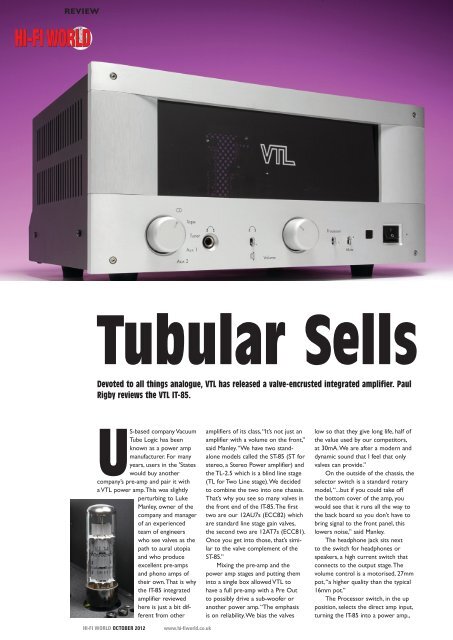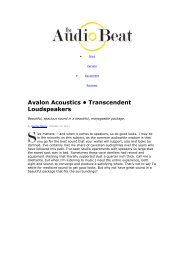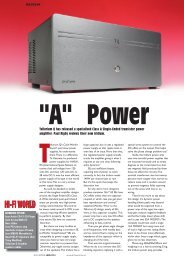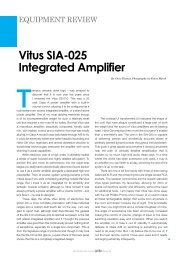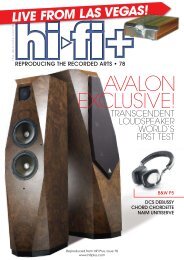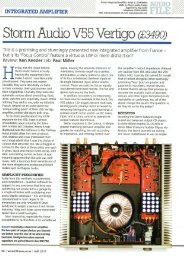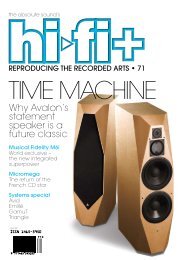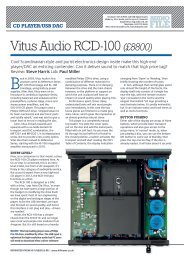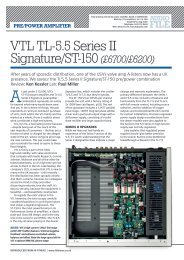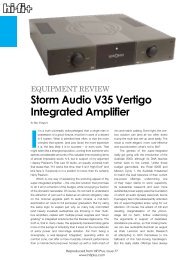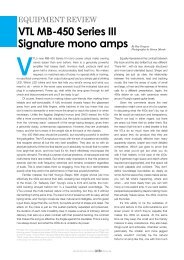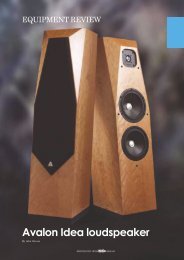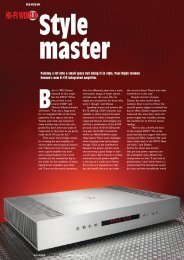It's - kog audio
It's - kog audio
It's - kog audio
You also want an ePaper? Increase the reach of your titles
YUMPU automatically turns print PDFs into web optimized ePapers that Google loves.
REVIEW<br />
HI-FI WORLD<br />
Tubular Sells<br />
Devoted to all things analogue, VTL has released a valve-encrusted integrated amplifier. Paul<br />
Rigby reviews the VTL IT-85.<br />
US-based company Vacuum<br />
Tube Logic has been<br />
known as a power amp<br />
manufacturer. For many<br />
years, users in the 'States<br />
would buy another<br />
company’s pre-amp and pair it with<br />
a VTL power amp. This was slightly<br />
perturbing to Luke<br />
Manley, owner of the<br />
company and manager<br />
of an experienced<br />
team of engineers<br />
who see valves as the<br />
path to aural utopia<br />
and who produce<br />
excellent pre-amps<br />
and phono amps of<br />
their own. That is why<br />
the IT-85 integrated<br />
amplifier reviewed<br />
here is just a bit different<br />
from other<br />
amplifiers of its class, “It’s not just an<br />
amplifier with a volume on the front,”<br />
said Manley. “We have two standalone<br />
models called the ST-85 (ST for<br />
stereo, a Stereo Power amplifier) and<br />
the TL-2.5 which is a blind line stage<br />
(TL for Two Line stage). We decided<br />
to combine the two into one chassis.<br />
That’s why you see so many valves in<br />
the front end of the IT-85. The first<br />
two are our 12AU7s (ECC82) which<br />
are standard line stage gain valves,<br />
the second two are 12AT7s (ECC81).<br />
Once you get into those, that’s similar<br />
to the valve complement of the<br />
ST-85.”<br />
Mixing the pre-amp and the<br />
power amp stages and putting them<br />
into a single box allowed VTL to<br />
have a full pre-amp with a Pre Out<br />
to possibly drive a sub-woofer or<br />
another power amp. “The emphasis<br />
is on reliability. We bias the valves<br />
low so that they give long life, half of<br />
the value used by our competitors,<br />
at 30mA. We are after a modern and<br />
dynamic sound that I feel that only<br />
valves can provide.”<br />
On the outside of the chassis, the<br />
selector switch is a standard rotary<br />
model, “...but if you could take off<br />
the bottom cover of the amp, you<br />
would see that it runs all the way to<br />
the back board so you don’t have to<br />
bring signal to the front panel, this<br />
lowers noise,” said Manley.<br />
The headphone jack sits next<br />
to the switch for headphones or<br />
speakers, a high current switch that<br />
connects to the output stage. The<br />
volume control is a motorised, 27mm<br />
pot, “a higher quality than the typical<br />
16mm pot.”<br />
The Processor switch, in the up<br />
position, selects the direct amp input,<br />
turning the IT-85 into a power amp.,<br />
HI-FI WORLD OCTOBER 2012<br />
www.hi-fiworld.co.uk
y-passing the pre-amp section. The<br />
next button is Mute selector.<br />
The safety cage can be removed<br />
to replace valves or bias the amp.,<br />
because this is a Fixed Bias design -<br />
meaning bias needs adjustment every<br />
few months.<br />
Around the back, the speaker<br />
binding posts are situated at an angle:<br />
it saves a bit of space and doesn’t<br />
bend the cable at such a drastic<br />
angle when spade connectors are<br />
used. There are eight pairs of phono<br />
sockets including a Tape, Amp In<br />
and Pre-Out. There are no balanced<br />
sockets here, it would have taken up<br />
more space and would have cost a<br />
lot more.<br />
Inside? “It’s a classic circuit. The<br />
ECCC82 line stage is cascaded. This<br />
means that the first stage is driven<br />
which then drives the second stage,<br />
in sequence. The first half of the<br />
first 12AU7 (ECC81) is a buffer,<br />
the second half of that is the input<br />
stage for the power amp. The second<br />
ECC81 is the phase splitter for the<br />
push/pull output stage, then it’s a<br />
push/pull output stage (one EL34) for<br />
each phase. It’s a pretty simple circuit<br />
path, plus the output transformer.”<br />
Feedback is handled in a typically<br />
VTL manner, “There are two loops,<br />
one around the power amp and<br />
one around the preamp., because<br />
it consists of two active stages and<br />
this means that you can look at the<br />
two stages as standalone circuits.<br />
Keeping the feedback low gives you<br />
more emotional connection to the<br />
music. Increasing the feedback gives<br />
you great measurements and great<br />
speaker or amplifier control but the<br />
music becomes disjointed and boring.<br />
It’s no longer engaging.”<br />
Known for its meaty bass, the<br />
IT-85, spanning 400x300x180mm and<br />
weighing in at 27kg, prevents core<br />
saturation or soft bass problems by<br />
special attention to the transformer,<br />
“Some of our competitors have<br />
designed saturation into the output<br />
transformer so that it provides tone<br />
"one of the most ‘realistic’<br />
integrated amplifiers on the<br />
market"<br />
into the bass. I don’t want to do that<br />
because saturation means distortion.<br />
I don’t think that’s the right approach,<br />
I’m not after a ‘valve sound’, I’m<br />
after an accurate sound. Valves<br />
should be linear and accurate. The<br />
bass is sorted via our use of solid<br />
state rectifiers. We don’t use valve<br />
rectifiers or regulators. The purists<br />
would say that you have to go ‘all<br />
valve’ but I don’t think that valves are<br />
ideally suited to power supplies, they<br />
are not very linear current devices,<br />
they wear out and they can collapse.<br />
If anything, this design lowers<br />
distortion because you have a stiffer<br />
power supply and better<br />
regulation.”<br />
SOUND QUALITY<br />
Slipping Skunk Anansie’s<br />
‘Hedonism’ into my<br />
Densen B-475 CD player,<br />
the bass was different<br />
when compared to my<br />
reference Icon MB845<br />
monoblocks. The VTL<br />
provided a slightly dryer<br />
tone. There was just as much<br />
thump with possibly a touch<br />
less mass that gave the VTL<br />
a little more focus. Although<br />
the Icon is known for its<br />
powerful and forceful bass, the<br />
VTL produced a more involving<br />
sound that dug down into the<br />
subtle low frequency range.<br />
What stood out like a beacon,<br />
however, was the raw emotion from<br />
lead singer, Skin, plus the instrumental<br />
separation in and around the ordered<br />
soundstage. The more insightful<br />
detail of the secondary percussion,<br />
such as tambourines, was deliciously<br />
highlighted and detailed. Connected<br />
with this was the low distortion<br />
levels spotlighted by the delicate<br />
cymbal work that could easily be<br />
discerned behind the loud, angry<br />
power chords of the lead guitar.<br />
Moving to jazz and Horace<br />
Silver’s ‘Cape Verdean Blues’, the first<br />
thing that attracted my ear was not<br />
the trumpet, sax or piano, but the<br />
quietly conscientious drum rolls that<br />
simmer beneath the brass leads.<br />
Onto the piano lead which, at<br />
any time, is deceptively complex in<br />
REVIEW<br />
HI-FI WORLD<br />
www.hi-fiworld.co.uk OCTOBER 2012 HI-FI WORLD
this piece and subject<br />
to blurring. The VTL<br />
succeeded in defining each<br />
note, zeroing in upon the<br />
complex solo piece to<br />
add tremendous focus<br />
that gave the keyboard a<br />
balletic thrill.<br />
The Icon thrived in<br />
extracting the emotional<br />
guts of the sax but the<br />
VTL went even further,<br />
adding a subtle yet<br />
important essence that<br />
provided a critical metallic<br />
flavour that was subtle yet<br />
significant in contributing<br />
to tonal colours. Call it ‘reality’,<br />
if you will, it provided what can<br />
only be called 'credibility' to the<br />
music.<br />
Stevie Wonder’s ‘Sir Duke’<br />
played like a dream, right from<br />
the off. The sense of air being<br />
blown into the brass, right from<br />
the first few bars, was palpable.<br />
The bass was never dominant<br />
here but the tightness and<br />
security that it offered formed<br />
a sonic backdrop that the other<br />
instruments worked against,<br />
adding pure groove.<br />
Turning to vinyl and spinning<br />
the Kansas album, ‘Monolith’<br />
on my Avid Acutus turntable.<br />
This LP suffers from a level<br />
of compression which does<br />
produce bright moments during<br />
vocal crescendos. The linearity<br />
of the VTL was evidenced here<br />
via an inherent honesty. There<br />
was no overt sweetness to<br />
colour the output. This is a<br />
compressed LP and the VTL was<br />
here to confirm that. Hence, the<br />
compressed vocals experienced<br />
upper mid lift while the treble<br />
was rather bright. The VTL<br />
added nothing to the slightly<br />
harsh tones, it was neutral all<br />
the way. It just told the bare<br />
facts of the recording of this LP.<br />
It also provided top quality playback<br />
of the rest of the track. Hence, bass<br />
was tight, well formed and characterful<br />
while the variety of additional<br />
percussive elements and considered<br />
guitar work sounded marvellously<br />
metallic in a rounded sense while the<br />
soundstage possessed enough room<br />
to allow each band member to have<br />
their moment in the sun.<br />
Playing the original jazz album,<br />
‘Chet Baker Sings’, this superior<br />
master showed what the VTL, for<br />
an integrated design, could do on<br />
the analogue plane. Baker’s cultured<br />
tones were expressive with a series<br />
of nuances that told of the subtle<br />
tonal vibration here and a delicate<br />
sustain there, while his trumpet<br />
The VTL IT-85 produced 54 Watts into<br />
a 4 Ohm load and 45 Watts into an 8<br />
Ohm load (1% thd) so it appears power<br />
matched for load values below 8 Ohms<br />
– a good thing. Most loudspeakers<br />
use 4 Ohm bass units and this is the<br />
common minimum load value of modern<br />
loudspeakers, one the IT-85 matches<br />
better than most. Being a U.S. amp. it is<br />
quite likely power matched to 4 Ohms.<br />
One pair of EL34s in push-pull<br />
typically produce 40 Watts in self-bias.<br />
The IT-85 uses fixed bias to get higher<br />
output but the 60 Watts VTL claim is<br />
optimistic. How much power you get<br />
from valves depends upon how hard<br />
they are run, but run them too hard<br />
and their lifetime is shortened. EL34s<br />
produce a good sound and are cheap<br />
though, making this issue less critical.<br />
The output transformers are good<br />
ones, as full output was produced<br />
at 40Hz, for 1% distortion. Midband<br />
distortion figures were very low too,<br />
around 0.1% as shown in our analysis.<br />
Frequency response was unusually<br />
wide, reaching 100kHz (-1dB). This is<br />
down to good transformers plus the<br />
use of feedback. The low end was not<br />
curtailed so LP warps will produce core<br />
saturation. There was plenty of gain,<br />
meaning high input sensitivity.<br />
The VTL IT-85 is basically well<br />
designed. It should provide clean bass,<br />
due to quality output transformers. It<br />
MEASURED PERFORMANCE<br />
playing was crystal clear. The lack of<br />
distortion provided a scarily focused<br />
delivery that gave the vocalist a<br />
real sense of being there, live, in<br />
the listening room. This humanism,<br />
the realism of reproduction from<br />
analogue source and and the IT-85 is<br />
what music is all about, I felt.<br />
CONCLUSION<br />
With a well recorded source, the<br />
VTL made me forget that I was<br />
listening to a hi-fi system at all. The<br />
music existed like a sonic projection.<br />
That’s what the VTL is capable of<br />
doing, becoming seemingly invisible.<br />
It is one of the most ‘realistic’<br />
integrated amplifiers on the market<br />
I feel and highly recommended.<br />
also develops plenty of power into low<br />
loads. However, squeezing 54 Watts of<br />
power from one pair of EL34s is asking<br />
a lot. NK<br />
Power<br />
45watts<br />
CD/tuner/aux.<br />
Frequency response 2Hz-110kHz<br />
Separation<br />
75dB<br />
Noise<br />
-82dB<br />
Distortion 0.23%<br />
Sensitivity<br />
120mV<br />
FREQUENCY RESPONSE<br />
DISTORTION<br />
REVIEW<br />
HI-FI WORLD<br />
VERDICT<br />
With a surprisingly strong bass kick,<br />
the VTL IT-85 provides a sense of<br />
passion and emotion that drags you<br />
into a performance.<br />
VTL IT-85 £5,100<br />
Kog Audio<br />
+44 (0)2477 220650<br />
www.<strong>kog</strong><strong>audio</strong>.com<br />
)<br />
FOR<br />
- engaging sound<br />
- clarity<br />
- insightful detail<br />
- bass response<br />
AGAINST<br />
- nothing<br />
www.hi-fiworld.co.uk OCTOBER 2012 HI-FI WORLD


